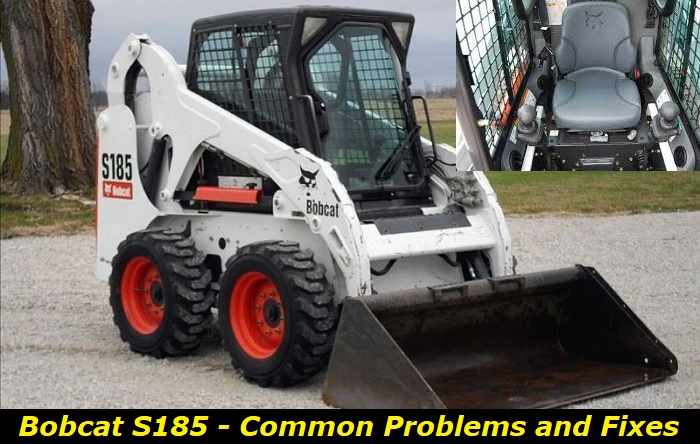Bobcat S185 Problems – We've Found Out All Common Issues
The Bobcat S185 sets itself apart from the tight competition with its more than average weight lifting capacity and plenty of other specs focused on delivering the best performance and reliability. Even though its production run only lasted until 2008, this model is still widely used in various applications, specifically in farming or construction business.
This was certainly a good product when it came out, but considering its age, there's a high probability that you may run into some of the problems commonly experienced by its operators by now. In this article, we will help you keep a lookout for its most common problems and show you ways how to address them.

Hydraulic Cylinder Drift
The Bobcat S185 is an incredibly versatile machine, capable of a wide range of tasks with the help of its hydraulic cylinder. It is important that the hydraulic cylinder be functioning properly in order to ensure efficient and safe operation. When the hydraulic cylinder fails to function correctly, it can lead to problems such as drift or sluggishness in certain areas. Diagnosing these issues can be difficult but is essential for ensuring proper functioning.
First and foremost, you must understand what causes this problem and how best to diagnose it through a test known as the hydraulic cylinder drift test. This test involves monitoring the amount of drift that occurs when the cylinder is operating and noting any discrepancies. Generally speaking, excessive drift can indicate a problem with the seals or pistons in the hydraulic system.
Once it has been determined that there is an issue with the hydraulic cylinder, it must be quickly identified as to what parts have failed and need to be replaced. The most common causes of hydraulic cylinder drift are damaged or worn-out seals on the piston heads, leaky valves due to corrosion, low pressure in the hydraulic line, a malfunctioning control valve, or incorrect connections between components.
Depending on what part needs replacing, oftentimes, just buying a new one will suffice. However, if more advanced repairs and installation are needed, then professional service may need to be called in.
It is essential to have a properly functioning hydraulic cylinder in the Bobcat S185, as it is what allows the machine to be utilized in such a wide range of applications. By understanding the common causes and being able to diagnose them through the hydraulic cylinder drift test, you can ensure that your Bobcat S185 performs at its peak every time.
Unresponsive Controls
The common causes of unresponsive controls in the S185 can range from a loose connection between cables or damaged cable insulation. These problems can be solved by checking for any loose connections and replacing any frayed wires or worn-out insulation, respectively. Other potential issues include bad switches or faulty wiring harnesses, both of which require replacement if they are causing the problem.
When it comes to identifying these components, there are certain parts that tend to fail more than others. For instance, the switch connecting the steering wheel to the power train and the wiring harness that connects various electrical components are some of the parts most likely to fail.
In such cases, these parts should be replaced in order to fix the issue. If you're lucky enough, their contacts may only be dirty and may only need a thorough cleaning.
To diagnose unresponsive controls, it is important to check for any visible signs of damage or fraying. It may also be necessary to use tools such as a voltmeter and other multimeters to pinpoint more specific issues within electrical systems. Checking connections between cables and inspecting wire insulation can help narrow down potential problems too.
Remember that whenever you are diagnosing electrical problems in your vehicle, you have to make sure that its charging system is working well first. See to it that the battery is charged and that the alternator is functioning as it should before gunning for the other possible causes of the problem.
Stalling and Starting Problems
Common causes of engine stalling and problems starting in the Bobcat S185 can include a number of things, from an issue with the fuel system to electrical or mechanical malfunction. Starting with the most common cause, fuel-related issues can be caused by a clogged air filter which impedes air flow into the engine, leading to a lack of oxygen and subsequently poor combustion.
This is usually avoidable with regular maintenance as it can easily be spotted during regular inspections. Another possible culprit is low fuel pressure which could stem from a variety of issues such as a defective regulator, worn-out pump, or blocked filter. The vehicle's ECU will detect this problem and send warning signals to alert you if any part needs replacement.
Mechanical problems can also be the cause of engine stalling, particularly if older components are present that have seen significant wear and tear. Things like spark plugs, ignition coils, or air intake valves may need to be replaced if they are faulty.
Loose connections in the system could also lead to engine stalling - something you should check regularly as part of your maintenance routine. Additionally, coolant leaks or incorrect fluid levels might interfere with the electrical systems on board and prevent the Bobcat from starting up.
Electrical malfunctions can likewise affect engine performance and require specific diagnosis processes in order to determine the root problem. This usually involves checking for any issues with sensors or wiring within the vehicle's electrical systems since these often go undetected during regular inspections. In some cases, you may need to replace damaged wires or sensors to get your Bobcat back up and running again.
There are many factors leading to engine stalling or difficulty starting in Bobcat S185s, each requiring its own unique solutions. Taking the time to diagnose the issue thoroughly is key as it will help pinpoint exactly what needs replacing or fixing for the vehicle to start and run properly again. Effective maintenance and regularly scheduled checkups should be considered part of owning this type of machinery so that any potential problems can be avoided before they become major issues.
Overall, engine stalling and difficulty starting in the Bobcat S185 are likely to be caused by several things. Fuel-related issues, mechanical faults, or electrical malfunctions could all be possible causes, so it is important to diagnose the issue thoroughly before attempting any repairs.
Regular maintenance should also form part of owning this type of machinery as it will help you spot any potential problems before they become bigger issues that require more extensive parts replacements. With careful consideration and adequate knowledge about what could be causing these types of difficulties with the engine, you can get your Bobcat back up and running again in no time.
Overheating Issues
Overheating in the Bobcat S185 can be caused by a variety of issues ranging from blocked cooling components and low coolant levels to problems with the thermostat or radiator. Generally, these issues can be identified through physical examination and certain tools.
When diagnosing an overheating issue, it is important to first look for signs such as warped paint on engine parts if the machine has been running hot for some time, or tips of coolant leaking from hoses.
Additionally, checking the fluid level in the radiator can help determine if there is a problem with the cooling system. If levels are too low then it is likely that there is a leak somewhere within the system, which needs to be addressed immediately. Inspecting fan belts for signs of wear is also important, as those components play a major role in the cooling system.
In addition to visual checks, diagnosing overheating issues can be aided by using tools such as thermometers and pressure gauges. Thermometer readings can indicate the presence of an issue such as low coolant levels or a failing thermostat while pressure gauges are used to assess fan belt performance. If either tool indicates a problem then it is essential to diagnose the cause and make repairs accordingly.
Common causes of overheating for the Bobcat S185 include blocked radiators due to debris build-up, faulty radiator caps that do not reach proper pressure levels, worn-out fan belts, low coolant levels from leaking hoses, and thermostats that fail to open.
If any of the above issues are identified then the necessary solutions include cleaning radiators, replacing fan belts, radiator caps, and hoses, or checking for faulty thermostats. In some cases, it may be necessary to replace parts such as water pumps and radiator tanks if these components have been damaged by heat.
In a nutshell, proper diagnosis of overheating in the Bobcat S185 relies on both physical inspection and using tools such as thermometers and pressure gauges. Common causes of the issue range from blocked cooling components to thermostat failure, while solutions involve repairing or replacing certain parts depending on the severity. It is important to address this issue promptly to avoid costly engine damage due to heat.
Conclusion
As with any other machine that is subjected to the rigors of time, you may run into some problems while operating the Bobcat S185. With the things discussed in this guide though, we hope that diagnosing the common causes of the problems found in the skid steer can be made easier and finding their solutions a bit more convenient on your part.

Add comment